Heart Matters – May 2023

Putting Radiation to the Test to Heal Irregular Heartbeat
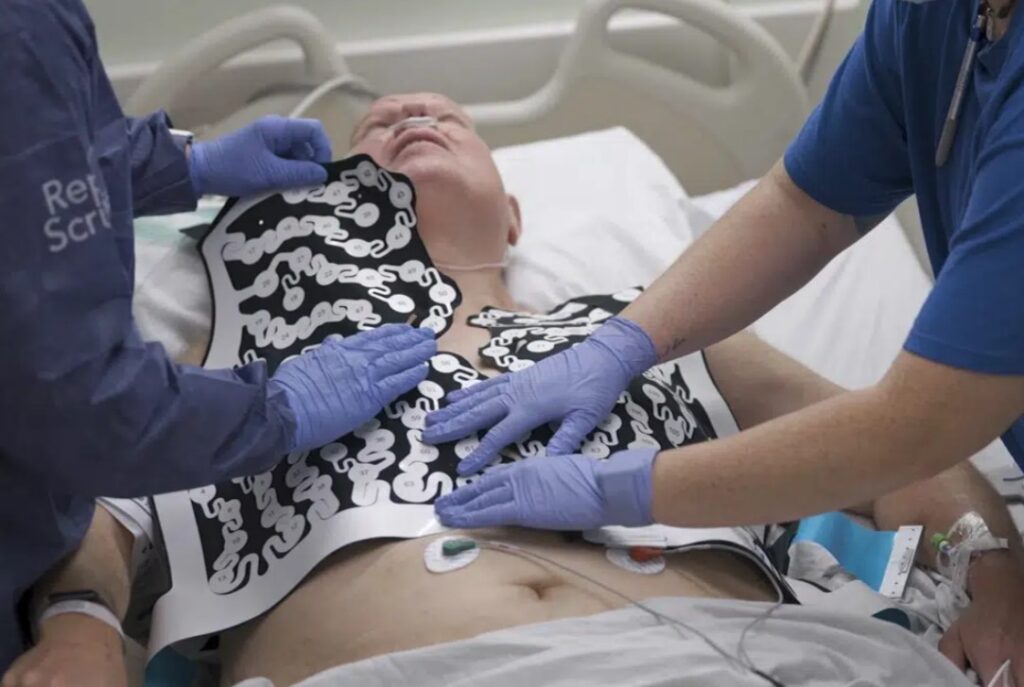
Doctors are zapping the heart with radiation normally reserved for cancer, a bid to better treat people with life-threatening irregular heartbeats who’ve exhausted other options.
While it’s highly experimental, surprising early research suggests it may reprogram misfiring heart cells to control heartbeats more like younger, healthier cells do.
“It may actually rejuvenate sick tissue, and that’s pretty exciting,” said Dr. Stacey Rentschler of Washington University in St. Louis.
An irregular heartbeat called ventricular tachycardia is a major cause of sudden cardiac arrest, blamed for about 300,000 U.S. deaths a year. Treating it with radiation is a radical approach — cancer doctors are trained to avoid radiating the heart at all costs for fear of collateral damage.
Now researchers are about to begin the first rigorous study to prove if a quick, one-time dose to fight this irregular heartbeat really works well enough — and is safe enough — for more patients like Jeff Backus, who relapsed after standard care.
The Louisville man already had undergone an hours-long invasive procedure to keep his heart beating properly, and had a defibrillator implanted as a back-up. Then this winter, twice in about a month, Backus briefly passed out and awoke feeling like he’d been kicked in the chest. The defibrillator had had to save him, shocking his heart back into rhythm.
“You’re always in the back of your mind thinking, ‘Is it going to happen?’” Backus said. Out of other options to prevent another scary episode, he chose the experimental radiation in February — and so far is doing well. “It gave me some hope.”
The heart’s electrical system normally makes it beat with a steady lub-DUB, anywhere from 60 to 100 times a minute. Ventricular tachycardia is a super-fast heartbeat, unable to properly pump blood. It happens when those electrical signals short-circuit in the bottom chambers, the ventricles, often because of damage from a prior heart attack.
The main treatment: Doctors thread catheters inside the heart to identify and burn the misfiring tissue, creating scars that block bad signals. Some patients are too sick for this “catheter ablation” and for others, like Backus, the problem eventually returns.
Doctors test radiation to treat risky heartbeat
Doctors are zapping the heart with radiation normally reserved for cancer in a bid to better treat a dangerous kind of irregular heartbeat. It’s highly experimental, but researchers at Washington University in St. Louis have reported success.
Dr. Phillip Cuculich, a heart rhythm specialist at Washington University, came up with the idea for a no-incision alternative.
It takes a lot of up-front testing. Patients get a souped-up EKG, donning a vest covered in about 250 electrodes instead of the usual dozen to measure the heart’s electrical activity. Adding that to detailed medical scans gives Cuculich a three-dimensional map pinpointing where the heartbeat goes awry.
How to reach it? Cuculich teamed with Dr. Clifford Robinson, who specializes in precisely focused radiation to attack cancer while avoiding nearby healthy tissue.
Aiming at the heart “wasn’t on my radar at all. My goal was to miss the heart,” Robinson said. After all, some lung and breast cancer survivors experience heart disease years later from tumor radiation that reached and inflamed heart tissue.
But he agreed to try, warning patients about possible long-term risks. His very first arrhythmia patient responded, “You’re concerned about something that might happen 10 or 20 years from now? I’m worried about tomorrow,” Robinson recalled. “That was really eye-opening.”
Patients lie in the same machine that normally blasts cancer, held in place and listening to music while customized beams hit the just the right spot. It can take as little as 15 minutes.
Cuculich and Robinson reported the first successes in 2017 and 2019, experiments with small numbers of desperately ill patients who showed dramatic improvement. They say some are doing well up to six years later.
While it’s not approved by the Food and Drug Administration, the duo has since gotten permission to treat about 80 more people on a case-by-case basis, some, like Backus, not as sick as the earlier patients. And the St. Louis team has taught the technique to dozens of other hospitals in the U.S. and abroad that are cautiously trying it.
But the FDA requires stronger evidence for more routine use — and the more hospitals offer “off-label” radiation to these heart patients, the harder it will be to get that proof.
Now in an international study, sponsored by device maker Varian, nearly 400 patients will be randomly assigned to either radiation or another catheter ablation to directly compare how they fare. Washington University just began recruiting potential participants; additional sites are set to open soon.
The bigger mystery: How the radiation prevents arrhythmias. Cuculich thought it would work by simply copying catheter ablation’s scarring but was stunned when scans showed “we weren’t actually causing a new scar — and that’s a big deal.”
Rentschler, a developmental biologist who also treats heart patients, took a closer look. Tests with donated human hearts and mouse hearts suggest the one-time moderate dose of radiation was prompting the misfiring cells to repair themselves.
In areas that got zapped, heart muscle cells temporarily switched on certain genes that normally are dormant in adulthood. Among them: a signaling pathway called “Notch” that helps a developing heart form its electrical system.
Reactivating that pathway “is perking up those areas” so they conduct electrical signals more like when they were younger, Rentschler explained. “We’ve never had any treatment that could do that.”
That’s very different than how repeat radiation doses can obliterate tumors. Now Rentschler’s research team is testing human heart cells in lab dishes, measuring exactly how they conduct electrical impulses — in hopes that even lower radiation doses might work.
“It’s really important that we get this right … that we figure out what the safe doses are and if there’s areas that we should be worried about,” Cuculich said.
Dr. Zainab Mahmoud Receives Eisenberg Scholar Award
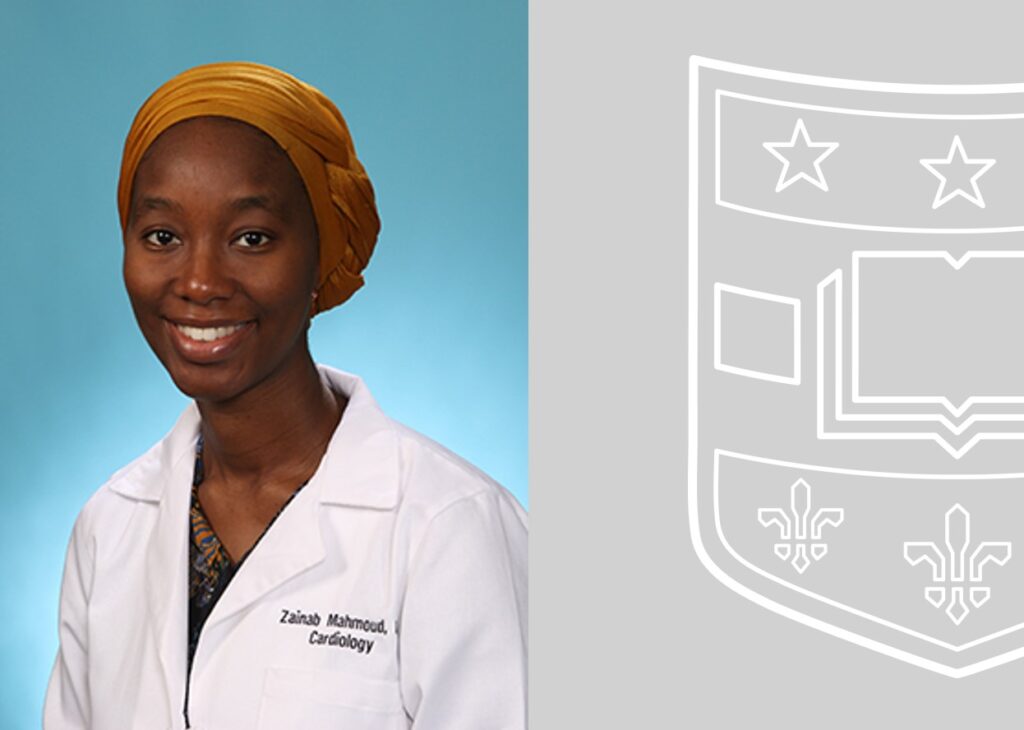
The Paul and Patti Eisenberg Scholar Award is presented annually by the Washington University School of Medicine Cardiovascular Division to fund junior faculty research that broadly focuses on cardiovascular disease. Funds should be used to generate key preliminary data and/or to develop new areas of research.
Dr. Zainab Mahmoud is this year’s recipient of the award, based on her application “Utilization of Aspirin for Prevention of Pre-Eclampsia in Nigeria: A Explanatory Sequential Mixed Methods Study”. This research has been selected for funding in the amount of $50,000.
Dr. Paul Eisenberg, former Professor of Medicine and CCU Director, and his wife Patti have generously provided funding for this award. Dr. Eisenberg recently stated “I was very fortunate to have had a rewarding and successful academic research career in the Division of Cardiology. We hope that this fund will give talented junior faculty the opportunity to start their research careers.”
Cardiovascular Faculty Members Inducted into ASCI and AAP
In April, four Washington University School of Medicine Cardiovascular Division faculty were honored at induction ceremonies for professional associations.
April 21st, the American Society for Clinical Investigation, or ASCI held their induction ceremony for newly elected members. Drs. Karen Joynt Maddox, Stacey Rentschler, and Rajan Sah were inducted to the society.
The ASCI is a nonprofit medical honor society composed of more than 3,000 physician-scientists from all medical specialties. The Society is dedicated to the advancement of research that extends understanding of diseases and improves treatment, and members are committed to mentoring future generations of physician-scientists.
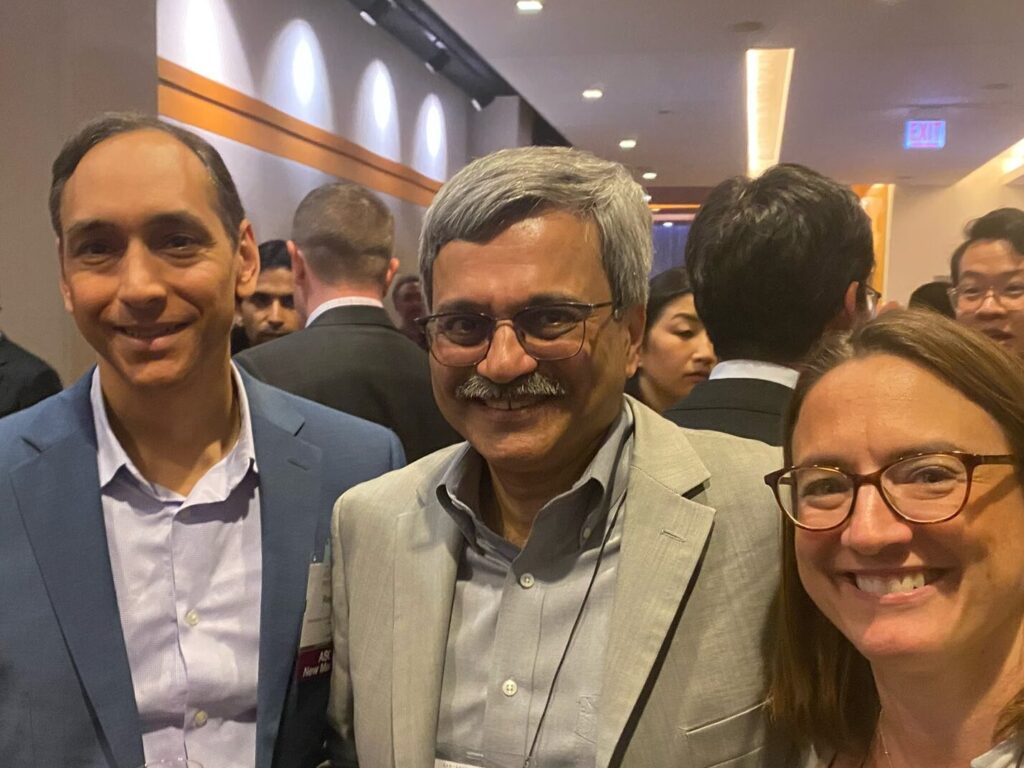
Founded in 1908, the ASCI is one of the nation’s oldest medical honor societies and is among the few organizations focused on the special role of physician-scientists in research, clinical care, and medical education, as well as leadership positions in academic medicine and the life sciences industry.
The following evening, the Association of American Physicians held their 2023 induction ceremony, at which Division Chief Samanth Prabhu, MD was honored as an elected member.
The Association of American Physicians (AAP) is an honorary medical society founded in 1885 by the Canadian physician Sir William Osler and six other distinguished physicians of his era for “the advancement of scientific and practical medicine.” Election to the AAP is an honor extended to physicians with outstanding credentials in basic or translational biomedical research and is limited to 70 persons per year. The AAP includes about 1200 active members and 700 emeritus and honorary members.
Dr. Anubha Agarwal Speaks at NIH Fogarty International Center LAUNCH Program Anniversary
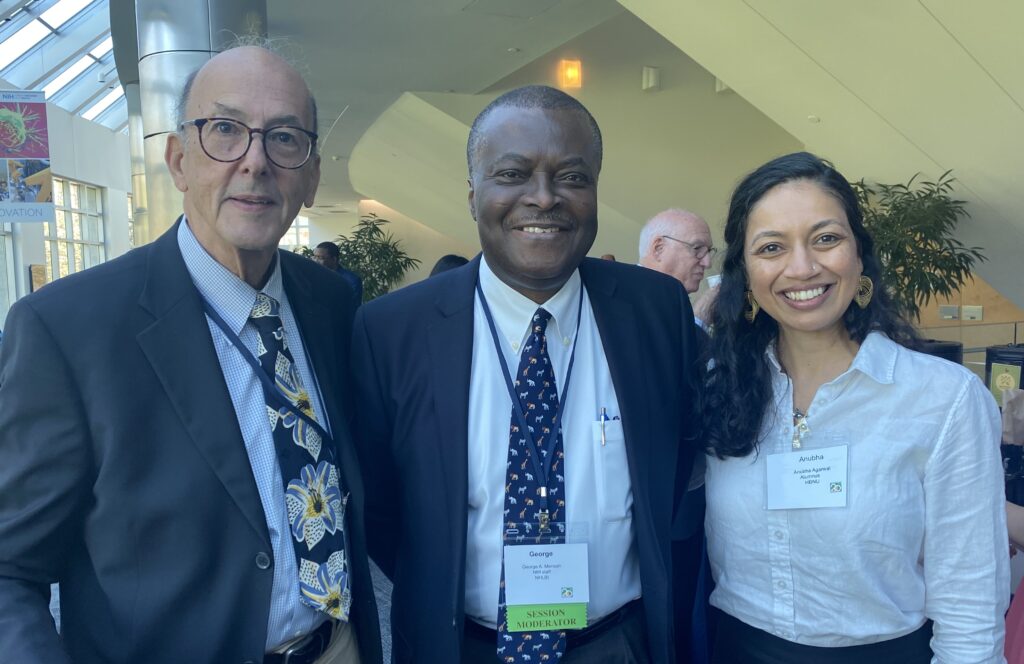
On April 13th, the Fogarty International Center at the National Institutes of Health celebrated 20 years of their Global Health fellows and scholars program, LAUNCH. Dr. Anubha Agarwal of the Washington University Cardiovascular Division was invited to speak on a panel of alumni of the program.
According to the NIH website, “The mission of the Fogarty International Center is to support and facilitate research, build partnerships, and train the next generation of scientists. Even in the short term, the Fellows and Scholars Program is highly effective in advancing these goals. The career trajectories of former trainees and their leadership roles in global health research, education, programs, and policies affirms that this program is a great long-term investment and a ‘best buy’ for Fogarty that should be continued long into the future.”
The overarching goal of Dr. Agarwal’s Fogarty year was to answer the question: How can we improve heart failure care in South India? She worked in the state of Kerala, where her first step was to conduct a systematic review of existing heart failure intervention programs. While many improvement programs existed, all had been studied and refined in high-income countries, making it a challenging to understand how they might work in her own low-income setting. Agarwal and her colleagues then took that data and conducted qualitative interviews with physicians, nurses, patients, and pharmacists, asking them what they think needs to be done to improve heart failure care. From there, they designed their quality improvement intervention and tested it amongst 1,400 heart patients in Kerala over six months.
Read more about Dr. Agarwal’s work with the NIH here.
Cardiovascular Care at Barnes-Jewish Hospital Recognized for Excellence
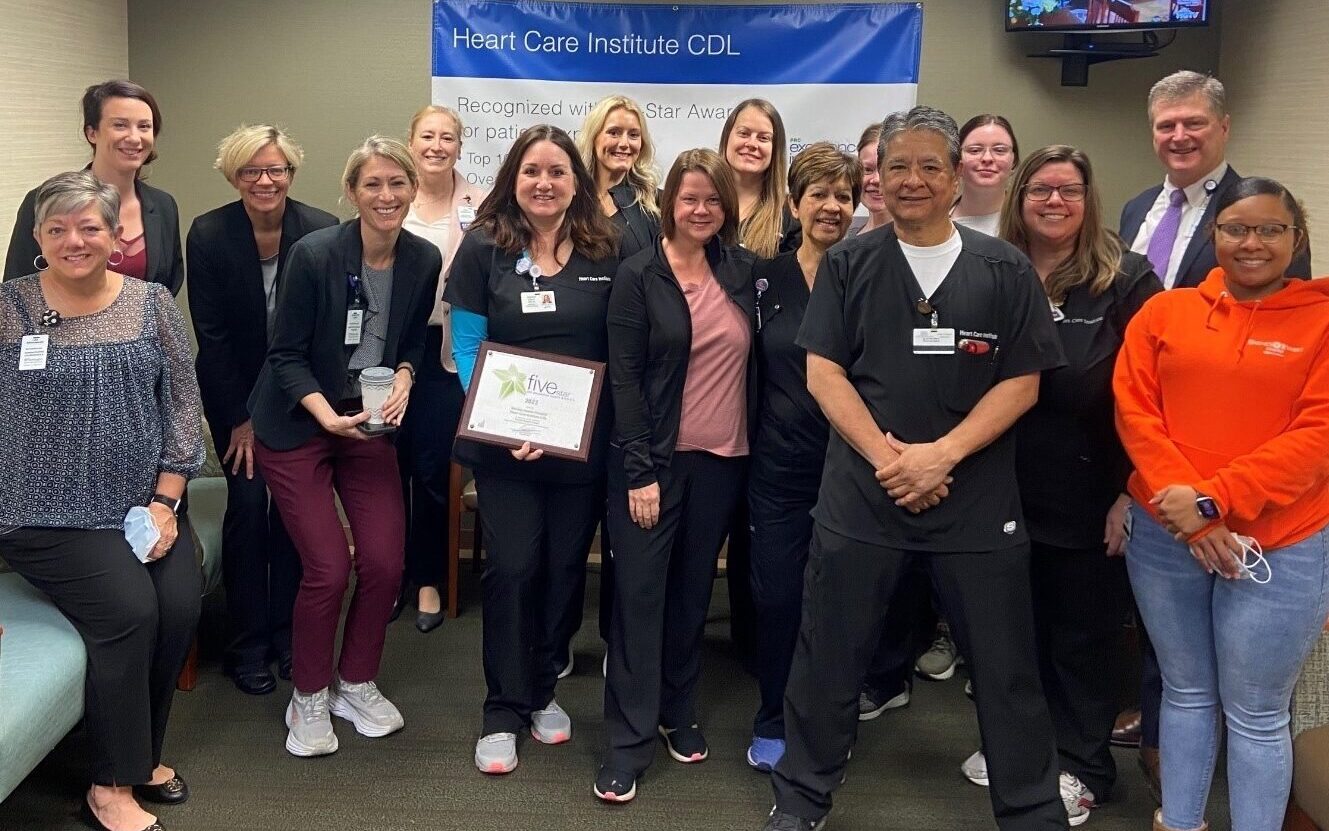
BJC hospitals, service organizations and medical practices earned a total of 171 PRC Excellence in Healthcare Awards in 2023, an increase of 20 over last year. Fifteen teams earned Top Performer awards, including the Cardiovascular Procedure Center and HCI, or Heart Care Institute.
The 2023 Excellence in Healthcare Awards were based on data from patient surveys for services performed in 2022. PRC contracts with hospitals nationwide to conduct patient surveys and the data are combined into PRC’s database to determine the nation’s best health care providers. The awards recognize the very top hospitals in the database in categories including individual inpatient units, outpatient facilities and departments, and overall hospital experiences.
“Patients encounter about 60 team members during an average 4 ½-day stay,” says Jennifer Carron, BJC patient experience officer. “The PRC Excellence in Healthcare Awards are based on our patients’ feedback, and these awards recognize that BJC team members work together to provide the best health care to our patients and true compassion to our patients and their loved ones.”
Earning 171 PRC awards is no simple task, especially amid ongoing staffing challenges. The Top Performer Award recognizes outpatient service lines, inpatient units, outpatient clinics and physicians/providers scoring at or above the 100th percentile in PRC’s database. The 5-Star Award goes to inpatient facilities, inpatient units, outpatient service lines, outpatient clinics and emergency departments scoring in the top 10% in PRC’s database. The 4-Star Award is given to inpatient facilities and emergency departments scoring in the top 25% in PRC’s database.
“These awards reflect the connection our BJC team members make with our patients and their loved ones each day,” says Carron. “It’s an intentional commitment to personally own and take responsibility for that human connection, combined with clinical skill and excellence, that embody the extraordinary care BJC provides. My cup is overflowing with gratitude for all our clinical and non-clinical staff, providers and leaders who give of themselves each and every day, and I’m looking forward to celebrating you.”
Barnes-Jewish Hospital was recognized with 12 awards:
Top Performers
- Pheresis Center – Center for Advanced Medicine
- Orthopedic Center – Physiatry
5 Star Award winners
- Breast Health – South County
- Cardiac Surgery 7200
- Interventional Radiology
- Bone Marrow Transplant 10800
- Cardiovascular Procedure Center
- Heart Care Institute CDL
- Leukemia/Lymphoma 9800
- Center for Advanced Medicine South County – Outpatient Surgery
- Orthopedic Center – Surgery
- Outpatient Infusion Center
The Science of Blues Hockey With Dr. Mustafa Husaini
Episode 6 of Barnes-Jewish Hospital’s web series The Science of Blues Hockey is available now! The episode features Dr. Mustafa Husaini, director of Washington University’s Sports Cardiology program. This episode, Heart of a Team Player, compares an NHL player’s heart to that of a non-athlete, and explores the importance of the heart in all systems of the human body.
Way to Shine!
“I want to give a Way to Shine to Lisa Winter and our EP nursing team on their patient care and documentation and the impact on the certification survey. They are doing an incredible job!”
“I just wanted to give a HUGE shout out to Emma for addressing TJC CCCC survey questions. Not only did she answer all the questions efficiently and effectively, she did it on a case that she really didn’t lead through the original process. I heard she did GREAT and represented us well, which is no surprise at all. So just a shout-out to you, Emma! So happy and proud to have you as my co-worker!”
Other Way to Shine’s for this month were Nikki Depew, Anne Buechler, Emma Stewart, Holley Crabtree, Emma Stewart, Emily Shaver, Lizzie Tullis, Katherine Ramsay, Joan Krull, Mandy Harris, Tori Menning, April Smith, Emma Heideman, Becky Menley, and Liz Cantoni.
If you catch someone in the act of shining, contact or send an email to bolhafner@wustl.edu.
Clinical Spotlight: Cardiac Rehab
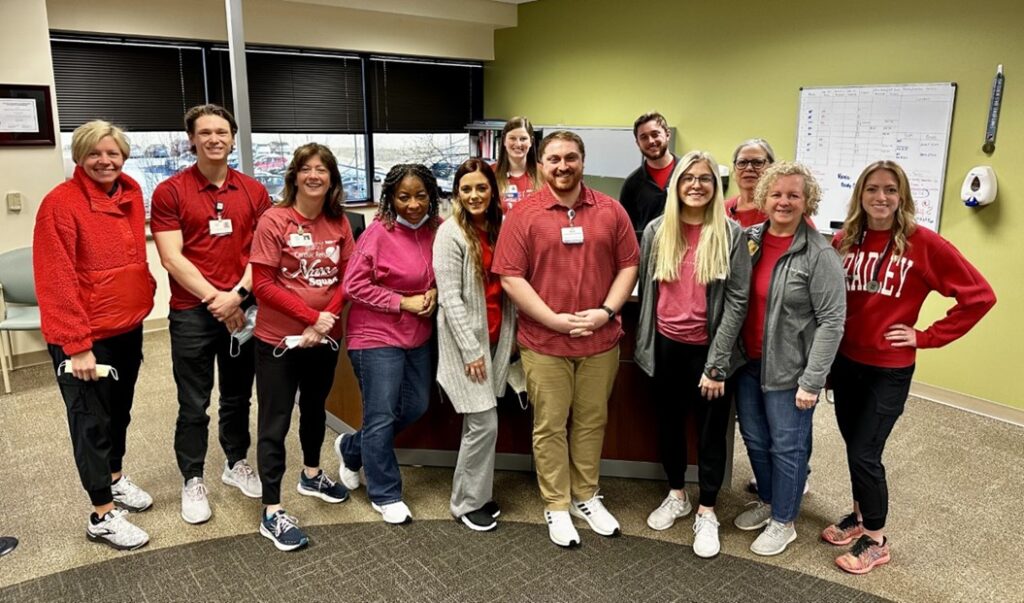
Each month, Heart Matters will highlight a research lab or clinical program. We want everyone in the division to be proud of the work we do across all of our locations and disciplines.
At the Heart Care Institute, located at the Barnes-Jewish West campus, the cardiac rehab program provides care and education to patients after they experience heart surgery or a serious cardiac event. The team of physicians, nurses, exercise physiologists, and dietitians work individually with patients to help them recover and strengthen their heart health.
Cardiac rehab is essential to recovery, and individuals who complete the program have greatly improved outcomes in re-admission, complications, and overall mortality versus those who do not. Barnes-Jewish West was also the very first facility to offer an intensive cardiac rehab option called the Pritikin program. Clinical Director Dr. Linda Peterson explains that Pritikin offers double the number of sessions for patients, and is covered by Medicaid and many other insurance plans. The outcomes and benefits of the Pritikin intensive cardiac rehab (ICR) are even more pronounced and life-changing for participants.
Instead of 36 sessions of exercise-based rehab, ICR patients have a total of 72 sessions; each of the 32 exercise sessions is accompanied by an education session where patients have individualized instruction on heart healthy eating (including nutrition, shopping, and cooking instruction), lifestyle, and healthy mind practices.
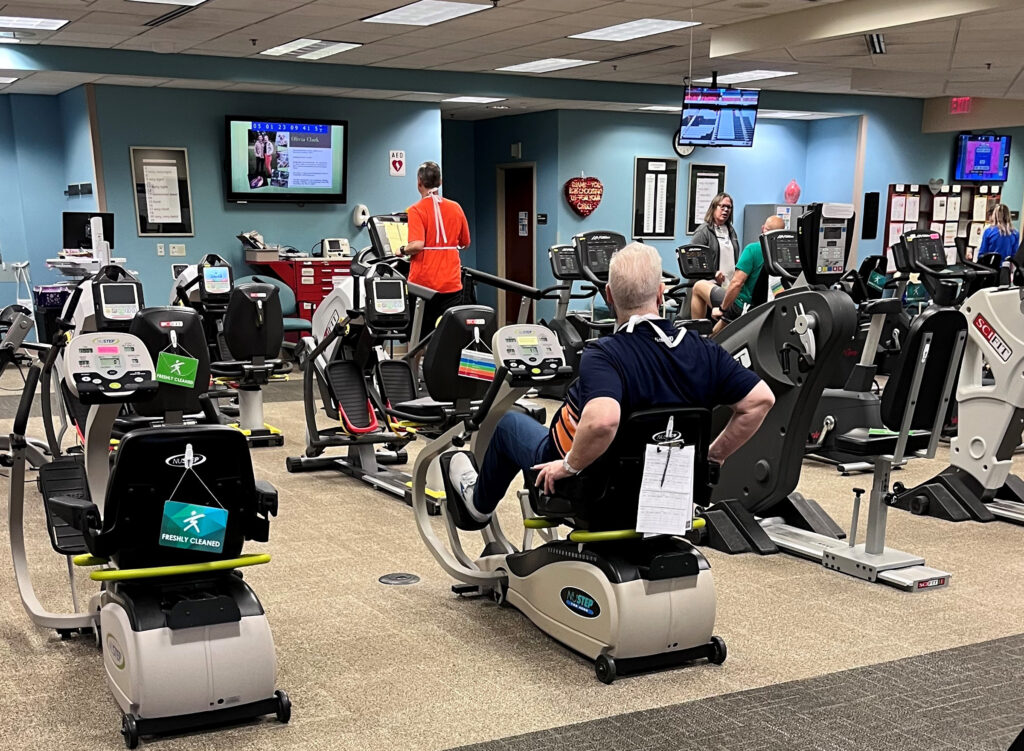
Nutritionist and Diabetes Educator Dotti Durbin works with patients to develop a diet that will accommodate their individual needs. She notes that the Pritikin diet is low salt, low fat, and low cholesterol, with a focus on eating lots of fruit and vegetables. It can be personalized for patients who have special dietary restrictions, or conditions like diabetes that require different considerations to be made.
With ICR, patients’ families can also participate in the education portions. This provides the patient with crucial support at home, especially if someone else is doing the grocery shopping and cooking in the home. ICR patients have lower BMI and improved mental health at the end of the program when compared with patients who complete traditional CR.
“Small changes add up”, says Durbin. “The more choices someone has to make, the harder it is.” She teaches participants shortcuts to look for healthier options based on a food’s nutrition label, such as looking for sugar in the first three ingredients, or comparing the sodium content to the calorie count. “If the sodium is less than the number of calories, it is a low sodium food”.
Nurse Manager Jennifer Jonagan has been at the HCI for 11 years. She loves working with the patients at cardiac rehab, and notes that since they complete the program over 12-18 weeks, the employees all get to know the patients and their families on a personal level. She has also seen an increase in the connection between patients since education classes have switched from individual rooms to a larger space where patients convene together and can compare experiences.
The HCI cardiac rehab team is providing state-of-the-art care to a diverse range of patients, and improving their health and quality of life after what can be a very difficult and scary experience. These patients benefit not only from the excellent exercise facilities and education programs, but from the fact that the physiologists, doctors, nurses, and dieticians all truly care about each patient and are invested in their outcomes. This clinical team is doing important and impactful work, and continues to exemplify excellence in patient care.
Meet Your Colleague
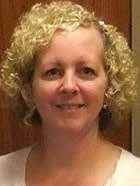
Dotti Durbin
Diabetes Educator
Fun Facts About Dotti
How long in the division: : 20 years in Cardiovascular division. 41 years at BJC including years spent working with heart transplant, physicians offices and at BJH. I love working in cardiac rehabilitation. We have a great team and I get to impact patient’s lives everyday sharing my love of good food.
Family: I am married to my high school sweetheart, Mike. We have a daughter and son. Our daughter and son-in-law have four little girls. Our son is recently married and about to renew their vows in their wedding in Italy in May.
Hobby: Cooking, gardening, aqua Zumba, walks with my dogs and of course most of my free time is filled with my granddaughters aged 6, 4, 2 and 9 months!
Favorite Food: Italian – veggie pizzas, pastas
Nickname: Dotti or Nana
Bucket List: Traveling to Europe (Italy) which I will be doing late May for my son’s wedding is definitely high on my bucket list.
Welcome, Baby Rishi!
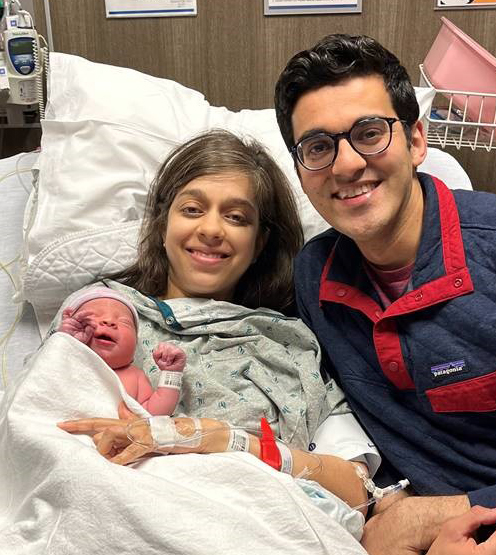
Dr. Farhan Katchi and his family recently announced an adorable new addition!
“We welcomed baby Rishi into the world on 4/15/2023. Mom and Rish are both doing well, thankfully. Big brother Devin was happy to meet his new baby brother but even happier about his new fire truck!”
Division Staffing Updates
Positions open for hiring:
JR70488 – Research Nurse Coordinator II
JR73337 – Research Nurse Coordinator I
JR72592 – Research Cardiac Sonographer
JR73575 – Billing Scheduling Associate I
JR73431–Postdoc Research Associate
JR74210 – Ultrasound Sonographer
JR73467 – Clinical Research Coordinator II
JR74120 – Clinical Research Financial Coordinator II
JR73579 – Research Specialist
JR74164 – Research Coordinator
JR74113 – Research Assistant
Welcome to the Cardiovascular Division:
4/1/2023 – Cara Alexander, Supervisor Coding
4/11/2023 – Alyssa Beck, Coordinator Residency/Fellowship
4/13/2023 – Catherine Cofield, Patient Billing/Services Rep II
4/17/2023 – Emma Porter, Medical Secretary II
4/24/2023 – Adam Hively, Clinical Research Coordinator I
Farewell:
Farewell to these Cardiovascular Division employees. Thank you for your service, you will be missed!
Kristin McKenzie, last day 4/17/2023
Casie Sutter, last day 4/27/2023
Laura Ewald, last day 5/19/2023
Farewell to our departing Faculty. We appreciate your contributions to the Cardiovascular Division.
Kartik Mani, MD held a position at the St. Louis VA Medical Center. He transferred to Iowa City VA Medical Center where he will be assuming the role of chief cardiologist. His last day was 4/23/2023.
Anita Bhandiwad was an Associate Professor in the Cardiovascular Division for the past 12 years. She was a general cardiologist with an interest in women’s health and imaging. She will be joining her family in Georgia. Her last day was 5/5/2023.
Health & Wellness
Summer Salads
Emma Greenhill, MS, RD, LDN
With summer around the corner, we all start eating a little better. The fruits and vegetables we love are coming into season and we might be getting ready to put on a swimsuit! But sometimes salads get boring, right? We all get stuck making the same salad we like over and over again until we are sick of it. So here are a few ideas about how to switch up your salads.
Nutrition. A mealtime salad should include vegetables, protein and carbohydrates. Vegetables can be anything though! It’s not just romaine and spinach. Try adding roasted brussels sprouts, broccoli, green onions (scallions), or zucchini. Classic veggies for salads also include avocados, carrots, red onions, bell peppers, and olives.
For the protein you could add hard boiled eggs, leftover chicken breast, baked turkey breast, grilled fish, shrimp, chickpeas, low fat cottage cheese, or nuts/seeds. Those are some of our most heart healthy protein options. Cheese, pork and beef provide protein as well but depending on the kind you buy it may be higher in saturated fat (the bad fat).
Some people skip the carbohydrate, but it makes for a much more filling salad when we include this macronutrient. Some carbohydrate options include fruit: mandarin oranges, cranberries, pineapple, strawberries, or granny smith apple. If you’re not big on fruit in your salads you could add roasted sweet potato, corn, butternut squash, peas, quinoa, whole grain pasta, or homemade whole grain croutons.
- Cobb Salad: Iceberg lettuce, cherry tomatoes, cucumbers, avocadoes, hard boiled eggs, low fat cottage cheese, turkey breast, and whole grain croutons.
- Taco Salad: Romaine lettuce, red onions, bell peppers, jalapenos, salsa, plain Greek yogurt (instead of sour cream), grilled chicken, black beans, and corn.
- Greek Salad: Romaine lettuce, tomato, olives, pepperoncini’s, artichoke hearts, low fat feta cheese, baked chicken breast, chickpeas, and Greek dressing.
- BBQ Salad: Mixed greens, white/red cabbage, green onions, pickles, grilled chicken, corn, roasted sweet potatoes, and a vinegar-based dressing.
- Fall Salad: Mixed greens, red onions, roasted brussels sprouts, baked salmon pumpkin seeds, dried cranberries, and balsamic vinaigrette.
- Apple Salad: Romaine lettuce, red onion, cheddar cheese, walnuts, and apples.
- Peach Salad: Mixed greens, red onion, goat cheese, almonds, and peaches.
- Strawberry Fields Salad: Spinach, red onion, pecans, sunflower seeds, grilled chicken, strawberries, and balsamic vinaigrette.
- Beet & Goat Cheese: Spinach, carrots, red onion, cooked beets, chicken, goat cheese, roasted potato wedges, olive oil + balsamic vinegar.
- Spinach Salad: Spinach, green onions, fish/shrimp, sesame seeds, mandarin oranges, whole grain cooked noodles (like a pasta salad), and Asian vinaigrette.
White Bean & Veggie Salad

Serves: 1 • Prep Time: 10 minutes • Total Time: 10 minutes
This meatless main-dish salad combines creamy, satisfying white beans and avocado. Try mixing it up with different seasonal vegetables to make it even more budget friendly!
Ingredients
- 2 cups mixed salad greens
- ¾ cup veggies of your choice, such as chopped cucumbers and cherry tomatoes
- ⅓ cup canned white beans, rinsed and drained
- ½ avocado, diced
- 1 tablespoon red-wine vinegar
- 2 teaspoons extra-virgin olive oil
- Freshly ground pepper to taste
Directions
- Combine greens, veggies, beans and avocado in a medium bowl.
- Drizzle with vinegar and oil and season with pepper.
- Toss to combine and transfer to a large serving plate.
Nutrition Facts:
Calories: 360 cal | Carbohydrates: 30 g | Protein: 10 g | Fat: 25g
More information at: https://www.eatingwell.com/recipe/259819/white-bean-veggie-salad/
Do you have BJC Cigna? Remember that you have annual coverage to meet with me, Emma Greenhill, a Heart Care Institute dietitian. Call 314-996-8165 for more insurance information or to schedule an appointment.
Wash U Medicine Climate & Culture Update
We have progress to report from the Executive Faculty Task Force on Climate and Culture regarding our work to ensure our campus is a safe and inclusive place for all who study and work here.
The formal kickoff with Catalyst begins this month. In last month’s message, we told you about Catalyst, an external consulting group that is providing guidance to help us see and understand what can lead to people feeling marginalized on our campus. Working with Catalyst, we are now in the process of gathering data on our past and current climate and culture. We have organized focus groups and leadership interviews for April and May. In late spring or early summer, you can expect to receive a climate survey administered by Catalyst. We look forward to your engagement – we want to hear your voices!
As part of our relationship with Catalyst, the School of Medicine is now part of Catalyst’s Supporter network, allowing us access to extensive data-driven research and learning resources. This membership means all School of Medicine faculty, staff, students and trainees now have access to an extensive library of online materials.
To access this network, register for Catalyst using your wustl.edu email address. After registering and signing in, you will have access to data, learning programs, tools, courses, webinar recordings, and other Catalyst resources designed to help improve climate and culture in the workplace.
Last month, we also launched our Community Discussion Sessions. Students and postdocs participated in the first sessions, led by the Office of Diversity, Equity and Inclusion. In April and May 2023, we will hold additional sessions for residents and fellows, staff, and faculty. Please click on Community Discussion Sessions to register. We aim to provide space for you to come together and reflect on our culture and climate. The sessions are facilitated using a restorative justice approach to acknowledge harm and support healing. Discussion themes (but not specific case details or personal identifiers) will be summarized and reported to the Task Force.
If you have questions or feedback for the Task Force, we encourage you to reach out via the online form or email us at medculture@wustl.edu. For more information about the Task Force, please visit our website, culture.med.wustl.edu.
Thank you for your efforts in helping the School of Medicine be the best it can be. We always welcome your input as we strive to build a climate and culture embraced by our campus community.
WashU Recognized As a Top Workplace
Washington University in St. Louis has been recognized in several recent surveys as a top workplace.
Forbes Magazine named Washington University the 69th top employer in the nation. The ranking is based on a survey of about 45,000 workers at American companies and institutions with 5,000 or more employees. Participants were asked if they would recommend their current employers to friends and family and to cite any other employer they also would recommend. The final list ranks the 500 large employers that received the most recommendations.
The St. Louis Business Journal named the university as a finalist in its annual “Best Places to Work” survey. The annual program measures 75 workplace factors such as communication, management structure, benefits and teamwork and surveys employees about their job satisfaction. WashU ranked high in benefits, employee engagement and other key metrics.
In addition, Washington University also won top honors in the 18th annual Health at Work Awards from ComPsych, the world’s largest provider of behavioral health and well-being services.
“The faculty and staff at Washington University are incredibly talented and deeply committed to our mission of education, patient care and research,” said Shantay Bolton, executive vice chancellor for administration and chief administrative officer. “I am proud of our work to support these employees through benefits that promote work-life balance, advance personal and professional growth and support their emotional and financial well-being.”
Washington University employs more than 19,300 people. Employees receive a range of benefits including tuition assistance, tax savings accounts and retirement savings plans. The university has added and expanded a number of benefits to improve employee well-being. Examples include:
- Direct access to mental health care through WashU Psychiatry
- Lower co-pays for employees and family members
- Expanded family emergency days
- Expanded sick time
- Flexible work schedules
- Financial literacy workshops
- Family and child care facilitator that helps employees find child and adult care
- Forgivable housing loan program (Live Near Your Work).
Bolton said the university will continue to introduce new initiatives to attract and retain top talent as part of “Here and Next,” the university’s 10-year strategic plan. Last month, the university introduced the Institute for Leadership Excellence, which will provide ongoing professional education to increase innovation, productivity and opportunities for all staff members.
BJWCH, BJC Health Care Week Activities May 7-13
Join your team members across BJC May 7-13 to celebrate the contributions you make to improving the health and well-being of our patients and communities during Health Care Week 2023!
In addition to the BJC activities, BJWCH has a lot of fun in store with a week-long carnival! Check out all events below:
BJWCH Activities
Download flyer for more details! Highlights:
- Monday, May 8, and all week: Candygrams! When you receive a BJC Shines, print it out and take it to the concierge desk at the main hospital between the hours of 4:45 a.m.-8 p.m. Monday-Friday or 6:30 a.m.-8 p.m. on the weekends. Concierge will give you a piece of candy and sticky tack to hang your BJC Shines recognition on the wall! For offsite locations, please consult with your leader on how to participate. BONUS: If you SUBMIT 2 BJC Shines for each core value during Health Care Week (10 total BJC Shines), then you’ll be entered into a drawing for a prize from BJC! See more under BJC Activities below. Download Candygrams flyer.
- Tuesday, May 9: Food Truck 10:30 a.m. – 1:30 p.m. at the main hospital and launch of Balloon Sculpture stations. Download Balloon Sculpture flyer with QR code to submit a photo of your sculpture for the events team to share across BJWCH! Please note that balloons contain latex.
- Wednesday, May 10: Big Top BBQ 10:30 a.m. – 1:30 p.m. at the main hospital. A buffet will be set up in the Education Rooms on the Ground Level; outdoor seating will also be available, weather permitting. Games and entertainment will be offered – stay tuned to the May 10 eConnect for more information on the BINGO game that will be available before, during and after the BBQ to play! Download Big Top BBQ flyer.
Boxed meals will be provided for STAR South County, STAR Chesterfield, ASC, and evening/overnight team members. - Thursday, May 11: Duo Therapy Dogs will be visiting various locations at the main hospital from 11 a.m. to 2 p.m.
Please note that team members who wear blue procedural scrubs are welcome to engage with the dogs, and they MUST change into clean blue scrubs before returning to work. - Friday, May 12: Don’t forget to submit guesses for the Baby Photo Game! Stay tuned to the May 10 eConnect for more information on how to play.
Bear Bucks Card System Replacement
WashU IT is replacing the system behind all Bear Bucks transactions in June, 2023.
This system replacement will impact how Bear Bucks users check their account balance and load funds to the card. Loading funds using payroll will no longer be an option with the new system, but the payroll charge option will remain.
The project team is working on developing training materials about how to perform both actions, and updating the information in ONE.WUSTL, it.wustl.edu, and the Campus Card Services websites. You will receive communication from IT when these initiatives are concluded.
NOTE: Physical cards will not have to be replaced as a result of this change, and account balances will not be affected by this initiative. Account balances will be tranferred from the current to the new system as part of the replacement .
We ask all faculty and staff to keep an eye on upcoming communication regarding this change to avoid future complications.
The Campus Card Services website will not be updated until the system replacement occurs. As a result of this decision, we ask all university schools and departments that mention Bear Bucks in their digital communication materials to point readers to the project webpage, where updated information about the system replacement can be found.
For questions or concerns regarding changes in Bear Bucks, email the project team.
WashU Physicians provide discounted procedures to WashU employees | LASIK
Say goodbye to contacts and glasses with LASIK surgery. WashU ophthalmologist Stephen Wexler, MD, is one of the area’s most reputable and experienced vision correction surgery experts. Dr. Wexler has performed 70,000+ LASIK procedures and uses the most innovative technology available. Schedule a free consultation.
IT Spotlight: Vulnerabilities, Threats, and Risks Explained
These three fundamental cybersecurity concepts are related but have distinct meanings. Security experts define these three concepts in a variety of ways, and the terms threat and risk are sometimes used interchangeably. This article’s definitions come from paraphrasing Computer Security: Principles and Practice by William Stallings and Lawrie Brown. Each term can be thought of in reference to an asset or “something that needs to be protected.”
- A vulnerability is a flaw or weakness in an asset’s design, implementation, or operation and management that could be exploited by a threat.
- A threat is a potential for a threat agent to exploit a vulnerability.
- A risk is the potential for loss when the threat happens.
Now, let us dive into each of these concepts.
Vulnerability
Identifying vulnerabilities is akin to answering the question, “How could harm occur?” Sometimes, a vulnerability can exist simply from an asset’s implementation or deployment. For example, a vulnerability is leaving your car unlocked in a public parking lot. Leaving the doors unlocked does not necessarily mean harm will occur, but it is an opening for someone to go through your car. Our office looks for vulnerabilities in WashU systems to catch them before bad actors can exploit them.
Threat
Identifying threats is akin to answering the question, “Who or what could cause harm?” In a broad sense, a threat is anything that could exploit a vulnerability and hinder the confidentiality, integrity, and availability of anything valuable. Threats can either be natural or human-made and accidental or deliberate. In our car example, the owner of the car did not lock their door, so a carjacker could exploit the opportunity. This means the threat is human-made and deliberate.
Risk
Once we know an asset’s vulnerabilities and threats, we can determine how much risk is posed to the asset owner. This measure is the combination of the likelihood that a threat exploits a vulnerability and the scale of harmful consequences.
Risk = (Probability that a threat occurs) * (Cost to the asset owner)
Despite the quantitative-looking nature of risk calculation, many risk analyses use qualitative ratings. This is because it can be extremely difficult to determine accurate probabilities and realistic costs, especially for intangible assets like trade secrets. The aim of risk analysis is to put risks in order of what is most urgent. This can also help the owner figure out how much effort and resources should go into protecting the asset.
Once again, let us circle back to the car example. If you drive a fancy car and keep valuables in it, then your cost is high. Also, if you park the unlocked car in a crime-laden area, then the probability that a threat occurs is also high. Combining these two factors shows your car is at elevated risk in this situation.
Managing Risk
The problem with risk is that, no matter how advanced our systems are, we cannot eliminate all threats. This is where risk assessment and management come in: a routine, ongoing practice where our office regularly reviews risks to minimize the potential for certain threats to occur.
You can find a list of our forms – including risk assessment forms such as the IT Procurement Vendor Intake Form and Web Application Risk Assessment – at Forms | Office of Information Security. For a list of approved external websites or cloud services to store, create or transmit WashU confidential or Protected information, visit Secure Storage and Communication Services.
| Keep up to date with IT news at the Office of Information Security blog |
Follow the Cardiovascular Division on Twitter!
Check out our division account, @WashUCardiology! We will be sharing division accomplishments, announcements, news, events, and more. If you have a story about the cardiovascular division that you think deserves a social media spotlight, email bolhafner@wustl.edu.